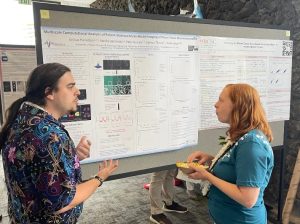Student Spotlight: Josh Hamilton
 We continue with our series featuring the nine graduate students who received research fellowships to focus on research last summer. Joshua David Hamilton, a biomedical engineering Ph.D. student advised by Andre Khalil, received funding for a project titled “Breast cancer case-control pilot study on patient-matched mammograms and histological tissue slides for NCI grant renewal proposal.” He took time to answer a few questions about the impact of the award, his experience at UMaine and plans for the future.
We continue with our series featuring the nine graduate students who received research fellowships to focus on research last summer. Joshua David Hamilton, a biomedical engineering Ph.D. student advised by Andre Khalil, received funding for a project titled “Breast cancer case-control pilot study on patient-matched mammograms and histological tissue slides for NCI grant renewal proposal.” He took time to answer a few questions about the impact of the award, his experience at UMaine and plans for the future.
What led you to UMaine and to your major?
My home town is Alton Maine and I learned about UMaine from my teachers at Old Town High School who directed me to an internship opportunity to conduct paid research over the summer at UMaine through the Maine EPSCoR internship program. I participated both my Sophomore and Junior summers of high school, first within the Chemistry department under Dr. Barbara Cole and then within the Chemical and Biomedical Engineering department under Dr. Douglas Bousfield. This ignited a passion for research and I discovered the Biomedical Engineering undergraduate program during this process. This led to me applying to an undergraduate in Biomedical Engineering at Umaine, participating in research all four years of my undergraduate, conducting a research based Honors Thesis, and being accepted into the 4+1 Biomedical Engineering program to obtain a one year Masters degree working under Dr. Andre Khalil and Dr. Karissa Tilbury. During my Masters I researched collagen organizational changes in relation to Pancreatic Cancer which has direct meaning to me as my step dad lost his battle to Pancreatic Cancer before my Sophomore year of college. I was extremely invested into my Masters research and had a conversation about staying in the lab for my PhD which resulted in where I am at today, a second year Ph.D. student in Biomedical Engineering through the Graduate School of Biomedical Science and Engineering.
What is a short description of the research project you are involved in?
I am currently researching organizational changes in the tissue micro environment to develop new diagnostic metrics and risk tools for clinicians as well as to help our understanding of how tissue organization impacts cancer growth. More specifically, my research has currently focused on developing novel wavelet and fractal based computational analysis techniques both on breast histological slides and mammograms.
How did the IoM fellowship make a difference?
I was under a TA-ship for my first year and there was no summer funding available for me. The IoM fellowship guaranteed I could continue my research which directly led to me presenting three posters from my work they helped fund. I presented at the International Breast Density Workshop in Hawaii, the Biomedical Engineering Society Annual Meeting in Seattle, and the San Antonio Breast Cancer Symposium in Texas.I am very thankful for these opportunities to both share my work and learn more about the research world around me.
What are some of your research tasks?
I help update, develop, and propose quantitative analytic methods based of hypotheses on how the underlying tissue organization could impact benign vs malignant tumors. This involves management of large image datasets, programming in multiple languages such as C++, R, Python, and TCL as well using an in-house lab program known as Xsmurf.
What were some exciting, rewarding moments, and some setbacks?
I proposed running what we call the “Anisotropy Factor” which is a quantitative measure of organization within an image on histological slide images from patient biopsies due to their immediate clinical relevance. We had never run this method on this type of image but I suspected the additional cellular information would be beneficial, whereas before we were analyzing images of just collagen taken using advanced microscopy techniques. The method works really well on the slide scans and finds differences in organization between malignant and benign breast tumor cases and now I am working on separating different cell types and underlying tissue types to create a more robust approach. Programming always can have tons of setbacks and mini victories with highs and lows almost every day. Research wise, we had fewer benign patients than we had hoped from our collaborators, but we still have found statistical significance suggesting we are on the right track and should pursue a larger histological dataset.
Would you like to recognize one or more faculty members, advisors, or administrative staff for their help?
I would not be doing any of the work I am without the mentorship of both Dr. Karissa Tilbury and Dr. Andre Khalil. They helped pull me from a low point in my life over the pandemic and have continued to support and offer me many opportunities and experiences I never thought I would have coming from rural Maine.
Can you see this research continued by others?
Absolutely, the goal is to release these tools to the wider research community and help direct researchers to using multi-scale wavelet and fractal techniques to further develop our understanding of cancer biology.
Will it have clinical applications?
Yes, currently some of our lab’s work in mammogram analysis is being transferred to clinicians under a startup company called Waved Medical under the guidance of a recently graduated CompuMAINE lab member, Dr. Kendra Batchelder. My current research on histology slides could one day be transferred directly into pathology workflow helping to ease their large workloads. In fact, the data I am using is on human patients from clinical collaborators and our lab is probably the largest clinical breast cancer project in the state of Maine.
